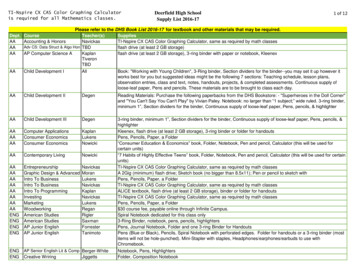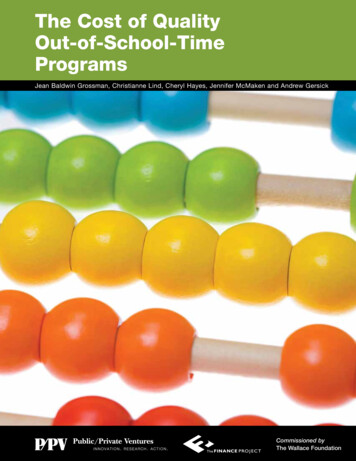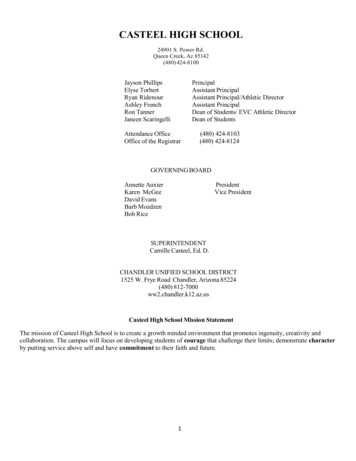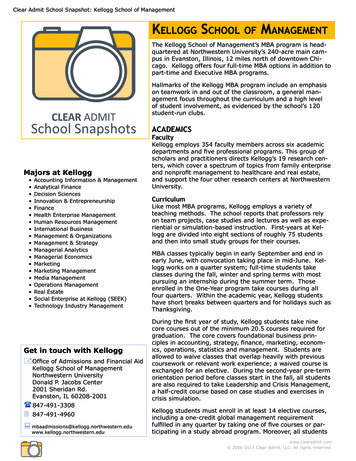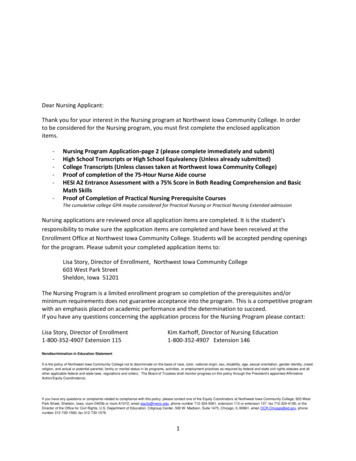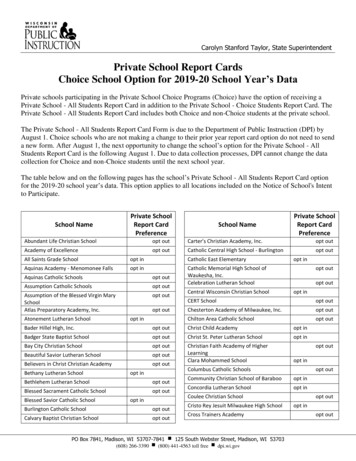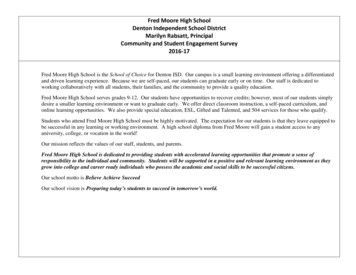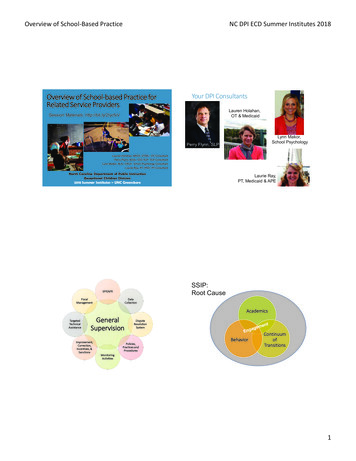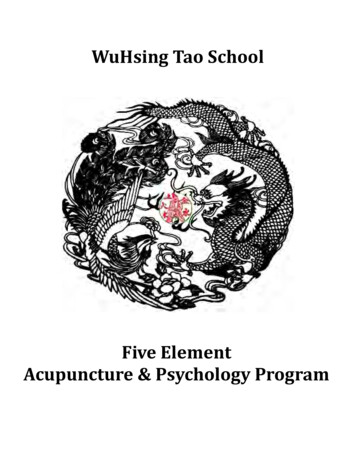
Transcription
WuHsing Tao SchoolFive ElementAcupuncture & Psychology Program
Dragon and Phoenixare holding a “Pearl,” the logo of WuHsing Tao.The Dragon is the Yang energy descending from Heaven, a gift and a blessing.The Phoenix is the Yin energy rising out of the ashes, Earth, born into a new creation.What is the meaning of this logo, this pearl?The “Pearl of Wisdom” is the beautiful philosophy of the FiveElements, teaching us how to use this system of medicine and live in harmony with Nature.“Inspired by a statue of a Bodhisattva, my brother, Leo Heinquet,a renowned painter living in Paris, created this image of a figure holdingthe hand in the teaching mudra, sitting in a landscape of the Five Element pictographs.”- Dirk HeinHow appropriate , the essence of WuHsing Taois depicted by the Archetype of compassion, teaching the world about a way to endall suffering. Every disease, physical, mental or spiritual, is a form of suffering. All efforts in medicineaim to reduce such suffering. WuHsing Tao, the “Way of the Five Elements”, is a way to re-empower Nature’sown inherent healing powers. Every healer knows that only Nature can heal. It is our task to study and searchfor a way to support Nature in that effort. WuHsing Tao’s mission is to teach the wisdom of the Five ElementSystem of Medicine, so that more and more compassionate practitioners can go out into the World and bringthose in need into “Harmony with Nature”, making all efforts to reduce suffering by restoring their health.WuHsing Tao SchoolTalaris World Campus4000 N.E. 41st St. Bldg. D,Suite 1, Seattle, WA 98105(206) 324-7188 / www.wuhsing.orgSeattle 2012, Vol. 33 / Published: May 1, 2012This catalog is certified to be true and correct in content and policy as of the date of publicationWuHsing Tao School is a fully licensed educational institution in Washington State and is certified by the Workforce Training &Education Coordinating Board under the authority of Chapter 28C.10 Revised Code of Washington Private Vocational Schools Act.
WuHsing Tao SchoolCatalogThe catalog of WuHsing Tao School is published for the purpose of providing applicants,students and the public with information about the educational program and policies ofthe school. The catalog is not to be regarded as a contract and may be modified following notice to students and approval by the Workforce Training and Education Coordinating Board.If, after reading the material contained in our catalog, you have become interested instudying this system of medicine, please contact the School's Admissions Officer forquestions, arrange for a visit or come to an open house.
About theDirectorDirk P. Hein has been in private practice for over 25 years. In 1987 he qualified as Master ofAcupuncture and received his M.Ac, (UK) degree from the College of Traditional Chinese Acupuncture in Leamington Spa, England, where he studied under the tutelage of the late Professor JR Worsley. He holds a teaching degree from the Worsley Institute of Classical Acupuncturein Florida for which he was a clinical tutor. He has been two-term president of the AcupunctureAssociation of Washington and two-term chairman to the Acupuncture Advisory Committee tothe State, setting standards and passing licenses.His teaching experience in Acupuncture includes that of a faculty member of the Worsley Institute of Classical Acupuncture, the Academy of Five Element Acupuncture, the Bastyr Universityof Natural Medicine, the Northwest Institute of Acupuncture and Oriental Medicine and theCanadian College of Oriental Studies. He started a specialized Five Element Acupuncture program and an exclusive clinic shift at Bastyr University Health Clinic. He has presented paperson diagnosis and treatment at the Northwest Conference on Acupuncture and Oriental Medicine for several years and appeared in a TV-Interview on Health, Mind and Spirit. He alsotaught Taoist Philosophy at Antioch University in Seattle.Dirk is the founder and director of the WuHsing Tao School. He created training programs forphysicians to become certified in Five Element Acupuncture, a full professional program accredited by the state of Washington, as well as creating a certificate counseling program in FiveElement Psychology. With his partner Chaitania, he also facilitates work-shops on the psychology of the Five Elements and their Archetypes, which use ritual, drumming, creative art play,drawing, brush painting, ritual, movement and theater to allow for a personal experience of theTao of the Five Elements.He is dedicated to the study and practice of medicine in the Five Element Acupuncture tradition. He has conducted many clinical Intensives and master classes in the United States withthe late Professor JR Worsley. Currently, he is in the process of writing a book on the philosophy of the Five Elements and Archetypal Psychology, as well as completing a Ph.D. in Educationat Akamai University.
Table ofContentsHistory of WuHsing Tao School1Mission Statement2Description of Traditional Five Element Acupuncture3-5Nature of the Program6-8Core Competencies9-10Professional Acupuncturist Program11-14Curriculum Format15-16Course Descriptions17-23Reading List24Admissions Requirements25-27Academic Policy28-30Professional Acupuncture Practice and the Law31The Facilities32Student Services33-34Financial Policy35Refund Policy36About the Academic Dean38About the Librarian and Lu-Sheng39Governance, Staff and Faculty40-41
History ofWuHsing Tao SchoolThe WuHsing School of Five Element Acupuncture was founded in 1997 by Dirk Hein fromstudents who wanted to learn this system of medicine, Classical Five Element Acupuncture.Dirk Hein is a senior practitioner, has a Master’s Degree from the College of TraditionalChinese Acupuncture, and is certified by Professor J.R. Worsley to teach Five ElementAcupuncture. Since 1980, Dirk Hein has also hosted many patient day seminars with Worsley. Thespirit of the teaching is strictly rooted in the tradition of Professor J. R. Worsley as passed down to DirkHein, his student of 18 years.To meet 21st century needs, Chaitania Hein brought the valuable expansion of psychology to theprogram. She teaches the psychology of Five Elements derived from acupuncture and Taoistphilosophy. She earned a master’s degree from Antioch University, writing her thesis on Five ElementPsychology and received a degree in that field.The School’s special emphasis is on developing the practitioner’s spirit, intuition, sense of service andthe creative drive that it takes to be committed to the pursuit of understanding, practicing and teachingof Traditional Five Element Acupuncture. The didactic curriculum is dedicated to acquiring theknowledge and expertise, that assures the fulfillment of all state and national professional requirementsof acupuncture education. The school continuously grows on the challenge to develop better ways totransmit this tradition, place it in the context of our contemporary civilization and it’s society, and findapplications of the Five Elements to help people and nature, the environment and its inhabitants.WuHsing Tao School has graduated so far: three graduating post-graduate classes for Five ElementAcupuncture, two graduating post-graduate classes for Five Element Psychology and 14 graduatingclasses of the full 3.5 years program. The first class graduated from the full 3.5 years program ofAcupuncture was in 2004. Patients from all over the Northwest come to be treated at WuHsing HealthCare by Dirk Hein, and from the WuHsing Tao School Clinic.1
Mission StatementThe mission of the WuHsing Tao Schoolis to develop Students into instruments of Five ElementAcupuncture, by incorporating acupuncture education, psychology,philosophy and the arts to graduate acupuncturists as health care providers.Education ObjectivesGraduates will be able to:1) demonstrate their knowledge and understanding of Traditional Five ElementAcupuncture, including its roots in Oriental medicine, philosophy and culture;2) utilize the skills necessary to diagnose the cause of the patient’s disease bydeveloping their ability to touch, feel, smell, see and hear, and to read the 12pulses;3) create a treatment plan for each patient that addresses individual needs;4) employ the range of clinical methods and techniques required to perform FiveElement treatments including needle insertion, moxabustion, point selection,and intent;5) demonstrate their understanding of themselves as embodiments of each ofthe Five Elements, and be able to adapt their treatments to the personality ofthe patient in order to provide the most effective care possible;6) demonstrate the knowledge necessary to identify medical emergencies andmedical conditions requiring referral to conventional or other health carepractitioners; and7) demonstrate their understanding of the requirements needed to operate alegal and effective acupuncture practice, including scheduling, patientmanagement, keeping and complying with all safety, legal andhealthcareprovider regulations.2
TraditionalFive ElementAcupuncturefrom the Worsley Tradition.A System of Acupuncture fromTraditional Oriental Medicine Rootedin the Taoist Nature Science of the Five ElementsTaoist monks and physicians practiced this system of healing for over 5000years. They noticed that the constant changes in nature followedpredictable patterns and that the interaction between the elements alwayscreated a renewed harmony and balance. Out of this discovery, they formulatednatural laws that explained this interdependent ecology. One of these principles,the Law of the Five Elements, became the foundation for this system ofacupuncture.Chinese Taoist scientists found that these forces of nature around them, the FiveElements or Five Forces, (“Wu Hsing” in Chinese), described certain qualities ofenergy that had corresponding counterparts inside every living being. Theelements they defined were Wood, Fire, Earth, Metal and Water. Theyrecognized the essence of these concepts not only as trees, sunshine, soil etc.,but also as metaphors for certain energetic qualities like growth, vitality, stabilityetc. By studying how these elements and their energetic characteristics effectedand controlled the internal organs, they discovered what would best be called a“physiology of energy”.In learning how to direct this vital energy to restore the organs’ naturalfunctioning, they found they were able to correct the imbalance that had causeddisease. Their pursuit and studies of this system were documented in theirwriting. These early medical texts have since become classics and are, in fact,the foundation of a truly holistic system of “Energy Medicine”.3
Five ElementAcupuncturefrom Oriental Medicineemphasizes the effectiveness oftreating the underlying cause of the disease,versus merely the symptoms, in order to effect a lasting cure.In treating the cause of the symptoms, the system of the Traditional FiveElements or “WuHsing,” focuses on assisting nature to right amalfunctioning organ and its energy circuit. This allows for all functions ofbody, mind and spirit to become equally strong again, eliminating the energydrain that any condition has on the whole system. In this way, the naturalbalance of vital energy that controls the function of all the vital organs, isreestablished, resulting in an improved state of health in body/ mind.In many cases, some time early in our life, the energy breaks down in oneparticular organ, creating a weak link. This leaves a predisposition for otherpossible illnesses later on in life. This original cause, the Causative Factor or“CF,” which is different for every person, is the key to treating a patientsuccessfully. One can see why, in this system, a great emphasis is placed ondiagnosis and treatment of the underlying cause, the Causative Factor, or CF.This approach proves to be very effective today, since in our contemporary time,the cause often lies not merely in physical and living conditions, but seems tooriginate from the mind or spirit level. The Five Elements or “WuHsing” bringforth a type of psychology of the Taoist philosophy addressing body / mind /spirit / soul. This holistic approach has proven itself to meet the needs of life inour society under the unique stresses of the twenty first century.4
WuHsingTao SchoolEducation in a Specialty MedicineTraditional Five Element Acupuncture diagnosis relies predominantly on the practitioner’sability to see color on someone’s face, hear sound in someone’s voice, smell someone’sdistinct odor, and perceive someone’s predominant emotion, along with pulse diagnosisand a complete life history. Therefore, the education involves the development andrefinement of the senses as specialized instruments of diagnosis.The refined perception that the practitioner gains does not always arise out of the rational mind, andmay even be called intuition. Yet it can be learned. An experienced and equally trained practitionercan confirm the diagnosis in the same way. This system requires the ability to “read between thelines,” and to assess the state of the patient’s energy as a whole on all levels: body/mind/spirit.At WuHsing Tao School the path of education in Traditional Five Element Acupuncture focuseson developing the student as an instrument of this system of healing. This requires developing thesenses as diagnostic tools, an inner knowledge of treatment planning, and treating the underlyingcause of any disease versus merely the symptoms.This program is designed to take diagnostic skill development as well as treatment planning to avery sophisticated level. The student will learn to treat even the most chronic and severe conditionsas successfully as the healing powers of nature will allow. As a very important part of the programand experience, students are required to be under the care of a Five Element Acupuncturepractitioner.Even though Five Element Acupuncture is a concrete system of medicine that works from a safefoundation of standardized guidelines, the graduate will also have the confidence to see and treateach patient as an unique person because he/she will have discovered the Five Elements inside ofhis/herself. Besides providing the necessary education in the history, philosophy and the mechanicsof this system, the program has the special focus of developing each student as an instrument ofhealing.Five Element Psychology is a system developed to assist the student to deepen his/herunderstanding of their Inner Nature, and have control of his/her own energetic life force. Thispsychological system is derived from the five thousand year old system of Chinese medicine, anduses the Five Elements to describe the energetic differences between people forming an “energetictypology.” Five Element analysis offers a continuous exploration in which self-realization can takeplace. Within the Five Elements are the Five Emotions. By learning to grasp the powers of the FiveEmotions and their nuances the student will not only become aware of his/her inner energy andinner nature, but also know how to specifically direct this energy outward, this energy that is alwaysbeing expressed through his/ her personality.5
Nature ofthe ProgramBecoming an InstrumentThe Five Element Tradition requires that the practitioner develops certain personal abilities andstrengths, as well as an increased sensitivity in order to become an instrument of this systemof medicine. Therefore, challenging the student to undergo personal growth is equallyimportant to making sure they understand the fundamental theories of this system ofacupuncture. In addition to gathering academic knowledge through seminars, study, memorization,assignments, point location, practicum and exams, the instructors will push the student to growpersonally into a practitioner able to diagnose and treat using the Traditional Five Element system.This system of medicine relies on the practitioner's ability to perceive manifestations of energy. Thestudents are asked to have an intellectual understanding of the mechanisms of the vital energy, butbeyond that, they are challenged to know this experientially. They are guided to observe changes inthe environment, in nature and also within themselves including their feelings and their emotions.From receiving personal acupuncture treatments, a requirement of the School, they begin todistinguish between energetic changes resulting from external circumstances and those resulting fromtheir treatments.The school's emphasis on psychology assures that the student develops responsible independentjudgment, is sensitive to the needs of others, is able to assess each situation and condition thatpresents itself in his/her practice, and meets the challenges of emotions and personal conflicts as theyarise.THE ESSENCE OF THE PROGRAMWuHsing believes we take our students on a journey. At the onset of this endeavor the students areintroduced to the concept, “becoming an instrument of this system of medicine”. Then as theyprogress through the program, they experience and understand how their training develops their abilityto embody and to manifest this concept energetically.We ask the students to contemplate and work toward embodying a set of core principles. Theseprinciples are taught through personalized exercises, art work and art experiences, literature andpoetry, 5E rituals, archetypal mask making, history and practice of calligraphy and Chinese brushpainting, and 5E psychology and Jungian principles. Putting these teachings into practice ultimatelyguides the student to become an instrument of Traditional Five Element Acupuncture.Core principles throughout the program: To be committed- to be authentic in every way, to look and live life through the lens of Nature,and in the belief that all of life is an aspect of Nature. To be in the pursuit of excellence- to do one’s very best at all times. To engage in “Art as a Way to Heal”- the participation in art can result in self discoveryand self expression, and ultimately leads the students to get in touch with their instinctualself. This awareness allows a connection to take place between the instinctual self andthe conscious self. As a result, the student can engage with themselves as a wholeperson, and embody their true Nature. Travel a path of “Self Realization”- this allows the development of self responsibility, in6
the face of knowing oneself without blame or projection.The cultivation of trust and truth – this cultivation results in the ability for intimacy to take place inthe student’s life, their community, and ultimately as a Five Element practitioner with their patient.To be in harmony with Nature– the integration of body/mind/spirit – the student must understandthe yin/yang dynamics at work, as well as develop courage and strength, and the ability to resistshrinking from harmony’s counter part, dissonance, if necessary.HOW THESE ESSENCES ARE TAUGHTPersonalized ExercisesWe have designed these exercises in order to engage the student in identifying and getting in touchwith each season and its corresponding Element and Emotion, within them self.ArtWe use art not only for self expression, but as a way to relax and open the mind, as well as to learnabout Nature and the Five Elements. The students at each seminar are engaged in one or more of thefollowing art forms: drawing; painting; movement (using the body to show the Archetypal Characters ofthe Five Elements); voice experience or singing (using the voice as an instrument of personalexpression); music (listening, playing an instrument or participating in a drumming circle). All studentsare encouraged to share any specific art that they are personally engaged in.Note: The strength of the art component at WuHsing is in its approach. We see art as somethingpersonal and as a process, not as a product or for an outcome. There is no emphasis on right orwrong ways, but only personal experiences and their expressions. The students and
gram and an exclusive clinic shift at Bastyr University Health Clinic. He has presented papers on diagnosis and treatment at the Northwest Conference on Acupuncture and Oriental Medi-cine for several years and appeared in a TV-Interview on Health, Mind and Spirit. He also taught Taoist Phil


